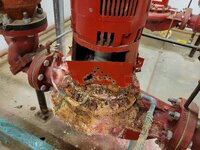Antifed
Mechanical
- Dec 19, 2005
- 27
 Hello,
Hello,I was on a site visit the other day and came across this Armstrong Pump in the secondary side of a heating hot water system. There are no corrosive chemicals in the room nor anything outside of the boiler room that could be drawn in from the combustion air louvers. The maintenance folks say that this is happening in multiple locations on the campus and in both the chilled water and heating hot water systems. Both the heating water and the chilled water have chemical injection systems. To my surprise, this pump was still running. There was no discernible leak. My supervisor thought that it may have been caused by a very small leak and stray currents. The only time that I have seen a pump and piping this badly corroded was in the pump room for a natatorium where the end-user kept the lid off of the chlorine tank.
Would you all be able to provide some ideas as to what could be causing the corrosion?
Thanks!
